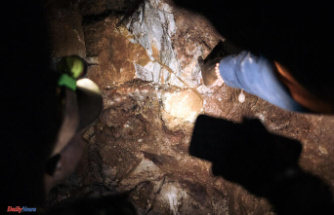From a distance, not the slightest thing can be made out on the rock. It is only when the group of kayakers, paddle by paddle, approaches the craggy rock that it becomes apparent: a couple is dozing in the Croatian sun and waving at them in a relaxed manner. Neither the woman nor the man are wearing swimwear, perfectly camouflaged with their seamless bronze complexions.
Anyone who explores the island of Rab will quickly notice that this freedom of movement is nothing unusual at all - at least it has been for 85 years. Because in August 1936, the then British King Edward VIII and his later wife Wallis Simpson docked at the then Yugoslav island on their sailing trip. During the stopover, the couple had an unusual request: the two wanted to bathe naked – and promptly received official permission for this.
Back then, they became sustainable trendsetters by just splashing about in Kandarola Bay. Rab is still nudist-friendly today, there are nudist beaches and naturist campsites, and holidaymakers like to jump into the deep blue of the Croatian Adriatic Sea in their Adam's costume even outside of the official nudist beaches.
There's no looking past it when kayaking. But even if the naked ones cannot be paddled, they remain an amusing side issue. After all, the multi-day tour is about something else: exhaustion and slowing down on the waves, nature experiences in the Kvarner Bay, getting to know the most diverse facets of the island from the water - after all, you can also reach places that are difficult or even only accessible by boat boat are accessible.
The ability to stay away from the tourist crowds is another aspect that lures vacationers into the kayaks. If you like, you can of course go swimming naked yourself in between, but when paddling everyone wears swimwear and a T-shirt. Just to protect yourself from the sun.
It would take five days to circumnavigate Rab completely. But there are also shorter tours. The small groups are always accompanied by two guides, who explain a lot about the island and, if necessary, explain the correct paddling technique to inexperienced people and take care of food and tent camping at different locations. On this tour, Bafo and his wife Lauren are in charge, both with many years of paddling and rab experience.
The tour starts from Rajska, the crescent-shaped beach in Lopar. It is wide and large and famous for its fine, light sand - something special in Croatia with its many pebble and rocky shores. On hot summer days there is hardly anything to be seen of the splendor of the sand, so close together are the colorful loungers and umbrellas of the Rab holidaymakers who love to swim.
The group doesn't notice anything. When she unloads kayaks, provisions and equipment from the trailer early in the morning and prepares everything, the bathing hustle and bustle has not yet begun, apart from a few pensioners who are awake in the morning there is no one to be seen.
Before the start, Bafo points into the distance. "In that direction is the steep, difficult-to-access east coast, only accessible by water" - and actually a popular destination for kayak trips because of its caves and unusual rock formations. "But the Bura is blowing too hard, so we're skipping that section." Which is a good idea, because constant headwind doesn't go well with deceleration.
Instead, the route is chosen so that the group can paddle in a relaxed manner. Only on a longer passage does the duel with the wind become a sporting challenge. With the kayak you then go against the waves, while the water keeps splashing up and you have to resist with stubborn, even paddle strokes.
Even without the east coast detour, it quickly becomes clear: This is an island of contrasts. When the ferry arrived in the port of Misnjak, Rab looked like a rocky island, almost like being on a rocky Aegean island. But the first impression was wrong. Rab is very green in large parts - with vines, olive trees, forests with pines and holm oaks.
Not only from Kamenjak, the highest point at 400 meters, but also from a kayak you can quickly see that Rab is one of the greenest islands in the Adriatic. The Illyrians, who called the island "Arp", already knew that, which means something like green wooded. Around half of Rab is still densely covered with trees.
Seen from the boat, the green is joined by the blue of the sky, the turquoise of the sea and again and again the brown and gray of the rock. "The neighboring island that you can see back there is called 'the naked island,'" says Bafo, pointing to a larger rock that becomes more prominent in the sea with every paddle stroke. But the designation has nothing to do with nudism, he quickly adds. "It's more because it's so barren and rocky."
Her name is Goli Otok. Because it was almost impossible to escape from there, it was used as a prison island for men during the Yugoslav era. "There were four attempts to escape from Goli Otok, only one was successful," says Bafo, directing the group to the shore of Sveti Grgur, the islet next to it, which served as a women's prison in the socialist era.
In the jagged rock you can see the viewing slits of dozens of bunkers at regular intervals, which are well camouflaged in the rocks. They were abandoned just before the breakup of Yugoslavia, as was the whole island.
In the bay where the first night's camp is set up, barracks in danger of collapsing and walls torn down, rusted bedsteads and old sinks are reminiscent of this dark island chapter. However, Sveti Grgur is not uninhabited: while the tents are being set up, a few trusting deer suddenly approach, eye the visitors without hesitation and, as ordered, stand in front of the photo lens with their mighty antlers.
The next paddling stages along the northwest coast of Rab lead past secluded bays, empty beaches and isolated holiday resorts such as Supetarska Draga. It is true that you sometimes paddle directly past other island guests who – sometimes naked – are basking on their boats.
From the kayak you get nothing else from the civilization, as experienced by most Rab tourists. Not even when going ashore at night, because overnight stays are in tents in lonely, wind-protected places on the rocky shore.
During the day, Bafo and Lauren always head for small beaches and remote bathing bays that the group has to themselves. If not, as during one of the lunch breaks on the Kalifront peninsula, a motorboat suddenly heads for the same bay. An older couple is traveling with it. It drops the anchor, jumps naked into the water and, shortly after the swimming break, disappears with the rattling boat as quickly as it came. After that it's quiet again.
On the last day, a detour to the tourist epicenter of Rab is on the program: the more than 2000-year-old old town of the island capital, which has the same name as the island and whose history dates back to Roman times.
From the water, however, nothing can be seen of the narrow streets with shops and cafés, ice cream parlors and restaurants serving fish, seafood and the island’s typical Rabska torta for dessert. Instead, the impressive remains of the city wall build up in front of the paddlers, behind which four striking church towers rise into the sky - Rab's landmark.
In the wooded Komrcar city park right next door, vacationers have taken refuge from the hot sun in the shade of the trees. A few jump into the water - this time in swimwear. So the last, great panorama from the water remains free of any nudist distraction for a change.
Note: This article was first published in August 2021. The information on providers and prices may vary.
Arrival: It is around 600 kilometers by car from Munich. There are flight connections to Rijeka, for example; from there it is best to continue with a rental car.
Best travel time: From May to October, whereby the off-season months of June and September are particularly recommended, because experience has shown that the sea is calmer then.
Kayak tours: Sea Kayak Croatia offers various tours: The island of Rab is completely circumnavigated during the five-day expedition. It costs 550 euros per person, including guide and food. However, you have to bring your own tent, sleeping bag and sleeping mat or rent them from the provider for an additional fee. Shorter and longer tours are also possible on request (seakayak.hr). Rab Activity also offers tours; a day tour with up to four people costs 160 euros, multi-day tours on request (rab-activity.com). In Lopar you can rent simple kayaks at the Moby Dick Diving Center from the equivalent of seven euros for one hour to a whole day (mobydick-diving.com).
Overnight stays: During the kayak tours, camping is usually wild and without sanitary facilities. There is a good selection of hotels in the old town of Rab: In the "Imperial Valamar Hotel" (four stars, two pools, sauna), for example, a double room costs from 78 euros per night with breakfast (valamar.com). The boutique hotel "Arbiana" offers classic luxury, it's only a few steps to the sea, double rooms from 125 euros (arbianahotel.com).
More information: kvarner.hr/deu/tourismus; rab-visit.com/de; croatia.hr/de-DE
The article was first published in August 2021.
Participation in the trip was supported by the Kvarner Region and Sea Kayak Croatia. You can find our standards of transparency and journalistic independence at axelspringer.de/independence.












